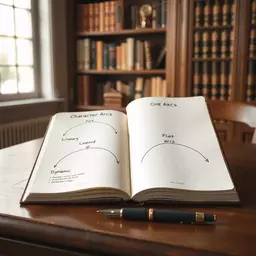Character Arcs Explained Simply
By Clara Eastwood / Nov 11
Did you know that a well-structured plot can make the difference between a reader putting your book down and staying up all night to finish it? Crafting an engaging narrative is both an art and a science, and understanding effective strategies for plotting can take your writing to the next level.
Understanding the core frameworks that guide plot development can enhance your storytelling. Below are the essential structures alongside their core components. For more detailed guidance, consider exploring effective plotting tools for writers.
When it comes to plotting a fiction story, having effective strategies is essential. These strategies help create a strong structure and ensure a smooth narrative flow. As a fiction writer, I can tell you that a well-planned plot allows your characters and story to shine, making your work more engaging for readers. Without a clear strategy, plots can become tangled and confusing, leaving readers lost and unfulfilled.
Effective plotting is about more than just having a beginning, middle, and end. It’s about creating a cohesive narrative that resonates with readers. This involves meticulously planning key events, character interactions, and emotional highs and lows to keep your audience captivated. Think of your plot as a carefully woven tapestry that invites readers in with its intricate details and rich colors.
Here are some core principles of effective plotting:
Understanding what your audience seeks is a critical part of successful plotting. Readers often look for stories that offer both entertainment and insight. This means you should focus on providing actionable advice and structured methods that resonate with their desires. Whether they are first-time readers or seasoned veterans, everyone appreciates a well-crafted narrative that speaks to their experiences.
To effectively connect with your audience, consider these tips:
Once you grasp the essence of effective plotting, it’s time to dive into foundational structures that can guide your writing. These frameworks help shape your story and provide a roadmap for your plot development.
Popular frameworks like the three-act structure, Freytag’s Pyramid, and the Hero’s Journey can serve as invaluable tools in your writing toolbox. Each of these structures offers a unique approach to storytelling, helping you organize your thoughts and ideas clearly. For instance, the three-act structure breaks stories into three distinct parts, allowing for a natural build-up and resolution. To help manage these structures, novel outline templates made simple can be incredibly beneficial.
Here’s a brief overview of these classic structures:
The structure of your story directly influences how you develop your plot. Each plot point serves as a crucial milestone that propels the narrative forward. By identifying these key moments, you can create a more engaging and structured story. For example, the inciting incident is where the main conflict kicks off, drawing readers into the narrative.
Here are some essential plot points to consider:
While established frameworks are helpful, it’s also vital to maintain your creative freedom. Rigidly adhering to a structure can stifle your creativity. The key is to use these structures as a guiding framework while allowing your imagination to flourish. Remember, your story is uniquely yours, and embracing this individuality makes for a more authentic narrative.
Incorporate creativity by:
By combining effective strategies, understanding your audience's intent, and balancing structure with creativity, you can create compelling plots that resonate with readers. At Fiction Frameworks, we’re dedicated to helping writers like you navigate this journey with clarity and confidence!
As you embark on your writing journey, we want to know what hurdles you face when plotting your stories. Share your thoughts below:
As we dive deeper into the craft of storytelling, it’s essential to recognize that every genre requires its own unique set of plotting strategies. Even within the realm of fiction, a mystery novel has a very different rhythm from a romance or a fantasy piece. This is where *advanced plotting techniques* come into play! Here are some strategies tailored for various genres:
Additionally, consider exploring *non-linear narratives*, which can offer fresh perspectives and enhance reader intrigue. By mixing up timelines or using flashbacks, you can keep your audience on their toes and deepen their connection to your characters.
In today’s digital age, it’s wise to leverage data when shaping your story. Analytics and reader feedback can be invaluable in refining your plot. Here are ways to incorporate these insights into your writing:
Adopting a *data-driven approach* not only enhances your plot but also aligns your story with what your audience craves. Just like at Fiction Frameworks, where we strive to provide writers with tools that resonate with their creative process, understanding your audience’s preferences can guide your writing journey! For further assistance in structuring your narrative, explore our flexible plotting blueprints for novels.
Themes and symbolism breathe life into your narrative, adding layers of meaning that engage readers on a deeper level. When crafting your plot, think about the underlying messages you want to convey. Here are some ways to explore themes:
By intertwining your themes with the plot, you cultivate a richer storytelling experience. Remember, a well-developed theme can resonate with readers long after they’ve finished the book!
So, let’s summarize the essential strategies and tools we’ve discussed for effective plotting:
These tools and strategies can empower you to create compelling narratives that resonate with readers. At *Fiction Frameworks*, we believe that every writer deserves the right resources to unlock their creative potential!
Now that you have these effective strategies at your fingertips, I encourage you to implement them in your writing process! Join writing communities, seek feedback, and explore the tools available to you. Remember, your story deserves to be told, and with the right plotting techniques, you can bring it to life! So let’s get started—grab your notebook and start crafting your masterpiece today! If you're just beginning, you might find starting your first novel together a great resource.
Here is a quick recap of the important points discussed in the article:

 Character Arcs Explained Simply
Every compelling story resonates with readers because of the evolution of its characters. Whether it
Character Arcs Explained Simply
Every compelling story resonates with readers because of the evolution of its characters. Whether it
 Outline Your Novel with Templates
Have you ever been stuck staring at a blank page, unsure of where to start? Outlining your novel can
Outline Your Novel with Templates
Have you ever been stuck staring at a blank page, unsure of where to start? Outlining your novel can
 Plotting Fiction: Strategies That Work
Did you know that a well-structured plot can make the difference between a reader putting your book
Plotting Fiction: Strategies That Work
Did you know that a well-structured plot can make the difference between a reader putting your book